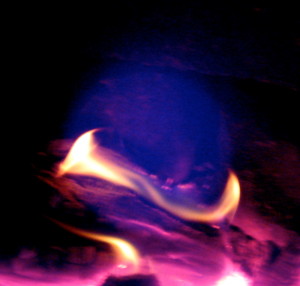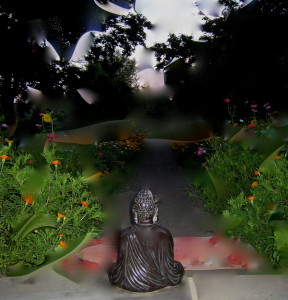
– Photo by Jan Ketchel
Intense emotional encounters with rage, desire, joy or love are encounters with powers greater than our ego selves. Whether we seek out or seek to avoid these encounters, they require tremendous ego-forging to successfully receive or withstand the energetic intensity of their impact.
The ancient Greeks were well aware of the otherworldly origin of these higher power emotions, assigning many to the gods and goddesses on Mt. Olympus. Many Greek myths capture the intensity of human seizure by such higher power emotions in romances between the gods and mortals.
This ancient respect for the non-ordinary human origin of intense emotion, with its volatile, ecstatic, and overwhelming impact upon our human selves, is largely lost to the modern world. Now the lone ego self, or rational self, is given the daunting task of owning and managing emotions of great intensity.
Following ancient tradition, Jung’s psychology assigns the numinous energy of intense emotion to the ego’s encounters with the spirit self in the realm of the archetypes of the collective unconscious. This dimension of the psyche exists outside of the parameters of everyday space and time, in the timelessness of eternity. The ego, in contrast, was born in the world of ordinary space and time. Encounters between these two worlds are highly charged energetic exchanges.
For example, to be seized by love is, for the ego, an inner encounter with the archetype or Greek god of love—Eros—who pierces the ego with a numinous arrow of otherworldly spirit energy that then flows into the ordinary confines of human interaction. Some egos, under such seizure, are unable to approach the ‘object of their desire,’ collapsing in frozen awe or feelings of unworthiness. In instances where contact is made, rarely can an individual or couple withstand the energetic impact of the encounter for too long, as the relationship inevitably slips into the stasis of the ungodly boredom of the mundane, into the ordinariness of everyday life. As the light of the divine spark dims, a couple is challenged to search inwardly for divine connection and human partnership.

– Photo by Jan Ketchel
Sexuality, as Freud and William Reich researched, is itself an interaction between ego and spirit energy. The ability to channel the highly charged spirit energy of orgasm requires the ego to relax its controls and constructions of ordinary reality to physically receive and commune with the divine energy of orgasm. Alexander Lowen spent his professional life developing Bioenergetics, physical movements to forge the ego’s ability to channel and receive spirit in ecstatic release.
The act of simply going to sleep similarly challenges the ego self to release control and receive spirit contact with its energy body in dreaming. In dreaming, the body self is completely immobilized to allow for this encounter.
In native American vison quests, the ego/body self is contained within a circle, bearing the tension of limitation, as it forges a vessel to receive a visitation from spirit self.
Christianity and Buddhism likewise engage physical stillness and limitation as the means of achieving divine encounters. Christ bound to a cross, bearing the tension of human suffering, is the context for divine connection. Buddha similarly bears the tension of the onslaught of human illusion as he sits in utter stillness, preparing to receive divine enlightenment beneath the bodhi tree.
At the culmination of the Jewish wedding ceremony, as divine energy pours into a couple, they forge a vessel of deeper commitment in human relationship by shattering a glass, in remembrance of the bearing of tension at the destruction of the temple in Jerusalem. In marriage, the ego self must bear the tension of suffering, as it makes contact with the divine, in joyful energy of union. The ego must be tempered to receive successfully the divine energy of joy.
Even the most modern of psychotherapeutic approaches boil down to forging the ego’s ability to suffer the influx of divine energy. In DBT therapy and Neuroplasticity, where the brain develops new channels to handle higher power emotional energies, treatment requires the ego self to learn to practice mindfulness. In mindfulness, we develop the ability to stay still and present—to manage and channel appropriately—encounters with highly charged spirit emotions.

– Photo by Jan Ketchel
Vedantic science developed yogic practices to enable the ego and body self the ability to become still and successfully receive contact with the deepest spirit self, the Atman that lives beneath the bliss sheath. In other words, this translates as union with the infinite self in the space and time of ordinary human reality.
The ultimate goal of all spiritual and shamanic practice is: to enter infinity with consciousness, to be able to bear the tension of divine contact without dissolution, to continue the infinite journey beyond human life in full awareness. For this purpose, we are afforded a life in this world.
Everyday life in this world offers us many opportunities to forge the ability to enter infinity with consciousness. As we bear the tension of the reality in this world, we also practice bearing the tension of forging contact with infinity. We practice how to receive it, withstand it, flow with it and, ultimately, to become it, with awareness.
Bearing the tension,
Chuck
